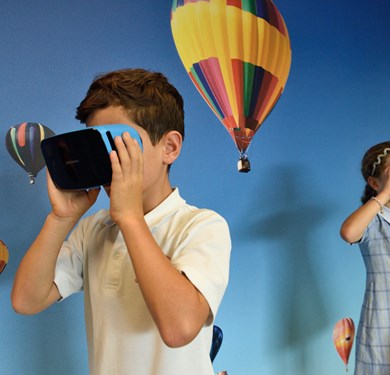5. Google Earth: An oldie, but a goodie. Google Earth gives us the opportunity to go on any Virtual Field Trip anywhere in the world! This is a fabulous tool for comparing and contrasting features of two different areas in Geography, as well as an affordable alternative to actually visiting the Pyramids of Ancient Egypt and the ruins of Ancient Rome, or even something as simple for those children that have not experienced a beach or the countryside. I recently observed a lesson where the children were taken to the Grand Canyon and had to complete a reasoning Diamond 9 activity with a collection of items that they felt were most important if visiting there. Although not a necessity, this coupled with Virtual Reality can really provide the most engaging lesson and equip children with knowledge and experience of places they have never been.
6. Photo Editing Apps: In 2021, our Art lessons should not be limited to pastels and charcoal. Photo editing provides children not only with the skills needed for some of our future jobs but also highlights the important issue that photographs can easily be edited. When teaching these lessons, it is crucial to discuss the airbrushing, editing and manipulation of pictures of celebrities in our magazines and films so that children know that things may not always be, as they seem. Another idea is to use an App like the ‘Voila Al Artist’ App that allows selfies to be changed into 15th century drawings.
7. Talkr/Chatterpix: Both these apps use the same face manipulation technology to make a picture ‘talk’. You upload a photograph, mark out the relevant features within the picture, and record your voice. The app brings the picture to life, making the mouth move, and eyes blink. This is fantastic when used as a hook, but also again to encourage the oracy and script-writing skills of children who are pretending to be a character from a book, bringing their own drawings to life, or simply pretending to be a hero of theirs. Children are much more eager to talk through a character than themselves. I have used this several times, for assessment opportunities, particularly in MFL lessons where the children display their new found “about me” language skills by pretending to be a famous person and introducing themselves.
8. Jamboard: Our school used Jamboard daily through Lockdown 3.0 and now continue to use it in discussion heavy lessons such as PHSE, R.E. or introductions and plenaries as it provides a way of recording evidence for these oracy heavy lessons. Jamboard can be used as part of Google Classroom (Google Meet) and works by allowing children to interact with a stimulus or work together in real time by adding digital post it notes, text boxes, pictures and drawings to either a blank Jamboard screen or a pre-prepared slide. Useful templates were shared across the school such as; a ‘thought car park’, where children add their ideas for a Key Question in each car parking space near similar thoughts, a digital Think, Pair, Share with thought-provoking stimuli. Furthermore, Yes/No Voting slides are perfect for an AfL check mid-lesson where children drag their names to which side they believe is right, and peer assessment opportunities within Art and D/T can be recorded by uploading and commenting 2 stars and a wish on photographs of children’s work (and that of artists/designers).



